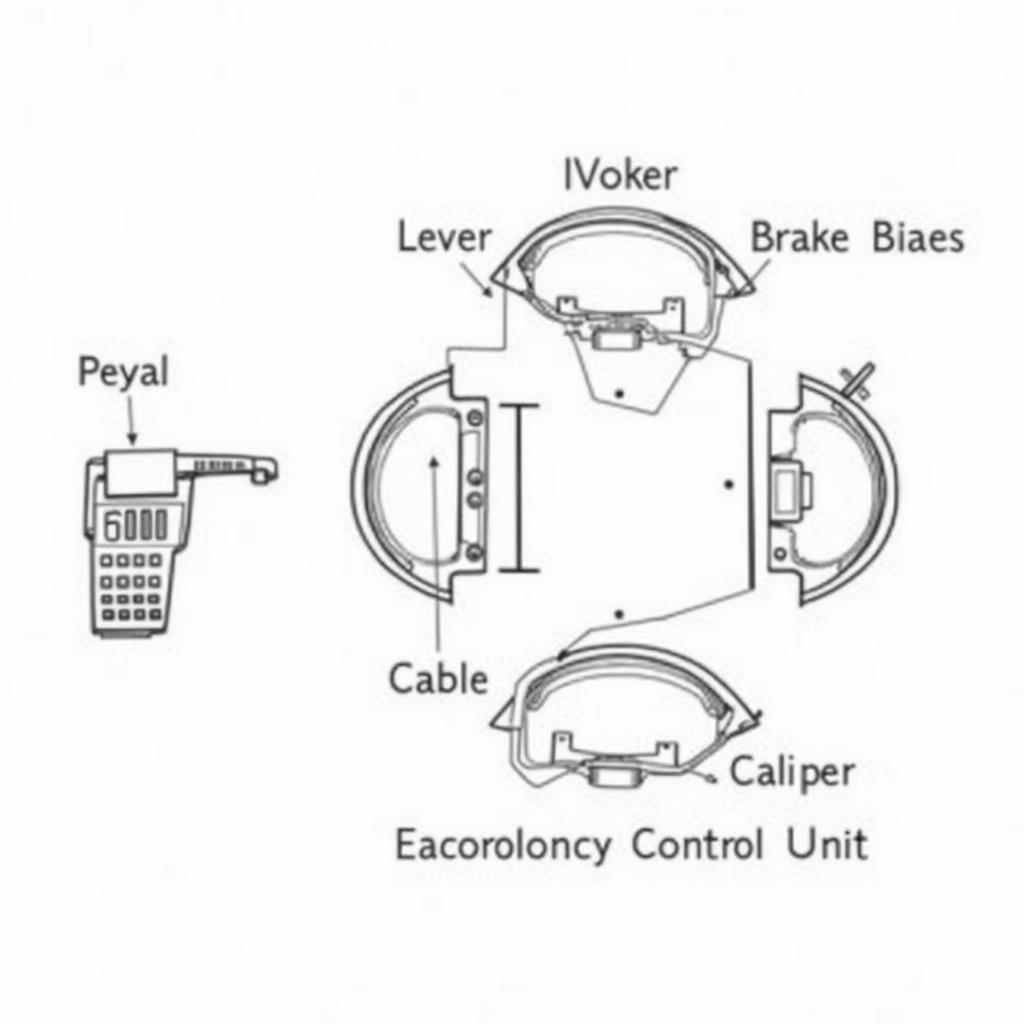The emergency brake warning light, often a red exclamation point within a circle, is a crucial safety feature in your vehicle. When illuminated, it signals a potential issue with your braking system, specifically with the emergency brake. Ignoring this warning light could lead to reduced braking performance and potential safety hazards. This comprehensive guide explores the common causes behind an illuminated emergency brake warning light and provides potential solutions to get you back on the road safely.
Understanding Your Vehicle’s Emergency Brake System
Before diving into the causes and solutions, it’s essential to understand how the emergency brake, also known as the parking brake or handbrake, functions. Unlike your primary braking system, which uses hydraulic pressure, the emergency brake operates mechanically or electronically.
In mechanically actuated systems, a cable connects a lever or pedal directly to the rear brakes. Engaging the lever or pressing the pedal tightens the cable, applying the brakes. Electronic systems, on the other hand, use an electric motor to engage the rear brake calipers.
 Emergency Brake System Components
Emergency Brake System Components
Common Causes of an Emergency Brake Warning Light
There are several reasons why your emergency brake warning light might illuminate. Here are some of the most common culprits:
1. Engaged Emergency Brake
The simplest and most common reason is an inadvertently engaged or not fully disengaged emergency brake. Even a slight engagement can trigger the warning light. Always ensure the lever is fully down or the pedal is completely released before driving.
2. Low Brake Fluid
Your vehicle’s braking system relies on hydraulic pressure generated by brake fluid. If the brake fluid level is low, it could trigger the emergency brake warning light, especially if the two systems share a reservoir. This usually indicates a leak in the hydraulic system, requiring immediate attention.
3. Faulty Emergency Brake Switch
The emergency brake switch is responsible for detecting whether the brake is engaged or disengaged. A malfunctioning switch, often due to wear and tear or corrosion, can send a false signal to the dashboard, illuminating the warning light even if the brake isn’t engaged.
 Close-up of a Corroded Emergency Brake Switch
Close-up of a Corroded Emergency Brake Switch
4. Worn Brake Shoes or Pads
While less common, worn brake shoes (for drum brakes) or pads (for disc brakes) can sometimes trigger the emergency brake warning light. As the friction material wears down, it can affect the engagement and disengagement of the emergency brake system, leading to the warning light.
5. Electrical Issues
Like any other electrical system, wiring problems, loose connections, or a faulty control unit (in electronic systems) can disrupt the signal flow, potentially causing the emergency brake warning light to malfunction.
Troubleshooting the Emergency Brake Warning Light
Here’s a step-by-step guide to help you troubleshoot a persistently illuminated emergency brake warning light:
- Check Your Emergency Brake: Ensure the lever is fully down or the pedal is entirely released. Sometimes, a slight bump or accidental nudge can engage the brake partially.
- Inspect Brake Fluid Level: Locate your vehicle’s brake fluid reservoir (refer to your owner’s manual) and check the fluid level. If it’s low, there might be a leak in your braking system, requiring immediate professional attention.
- Inspect Emergency Brake Cable: For mechanically actuated systems, visually inspect the emergency brake cable for any signs of damage, fraying, or sticking. A damaged or seized cable can prevent the brake from fully disengaging.
- Test the Emergency Brake Switch: You can test the functionality of the emergency brake switch by engaging and disengaging the brake while observing if the warning light responds accordingly. If it doesn’t, the switch might be faulty and needs replacement.
- Seek Professional Diagnostics: If the problem persists after these checks, it’s best to seek professional diagnostics. Modern vehicles are equipped with sophisticated electronic systems, and a qualified technician can use a diagnostic tool to pinpoint the root cause.
 Mechanic Using Diagnostic Tool on a Vehicle
Mechanic Using Diagnostic Tool on a Vehicle
Remote Diagnostics and Software Solutions
In today’s technologically advanced world, remote diagnostics and software solutions play a significant role in vehicle repair. With remote diagnostics, qualified technicians can access your vehicle’s computer system remotely, analyze error codes, and often pinpoint the exact cause of the issue, including problems related to the emergency brake system.
Moreover, software updates for various vehicle modules, including the electronic control unit responsible for the emergency brake, are often released by manufacturers to address bugs or improve performance. In some cases, a simple software update installed remotely can resolve the issue without needing physical intervention.
“Remote diagnostics and software solutions have revolutionized how we diagnose and repair vehicles,” says John Smith, Senior Automotive Engineer at XYZ Automotive. “These technologies allow us to address issues quickly, efficiently, and often remotely, saving vehicle owners time and hassle.”
Conclusion
The emergency brake warning light is a crucial safety feature, and ignoring it can have serious consequences. By understanding the common causes and following the troubleshooting steps outlined, you can often identify the problem. However, if the issue persists or you suspect a more complex problem, it’s crucial to seek professional assistance. Remember, a well-maintained braking system is paramount for your safety and the safety of others on the road.

